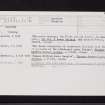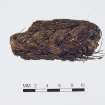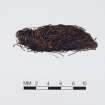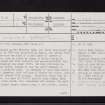Scheduled Maintenance
Please be advised that this website will undergo scheduled maintenance on the following dates: •
Tuesday 3rd December 11:00-15:00
During these times, some services may be temporarily unavailable. We apologise for any inconvenience this may cause.
Buiston
Crannog (Period Unassigned), Oar, Logboat(S)
Site Name Buiston
Classification Crannog (Period Unassigned), Oar, Logboat(S)
Alternative Name(s) Buston; Mid Buiston; Lochside; Biston; Swan Knowe
Canmore ID 42950
Site Number NS44SW 2
NGR NS 4155 4352
Datum OSGB36 - NGR
Permalink http://canmore.org.uk/site/42950
- Council North Ayrshire
- Parish Dreghorn
- Former Region Strathclyde
- Former District Cunninghame
- Former County Ayrshire
NS44SW 2 4155 4352
For a further logboat (Buiston 3) possibly from this locality, see NS44SW 34.
(NS 4155 4352) Crannog (NR) (site of)
OS 6" map (1968)
This crannog on Mid Buiston farm, was first discovered by McNaught in 1880 and excavated by Munro, who showed that its structure was that of a raft made of layers of branches, kept in place by rings of piles linked by wooden beams set both radially and concentrically; the total diameter was about 84ft. On this platform the house was built, though it was too badly damaged to obtain a detailed plan. It appeared to have been about 50ft in diameter, with walling of timber and stone, with a central hearth 10ft across. Artifacts found (now in the National Museum of Antiquities of Scotland (NMAS, Accession nos: HV 1-201) include bone combs, iron knives, iron punch, awl, spearhead and arrows, two gold spiral finger rings, bronze pins, a jet slider, whorls, flints, polishers, whetstones, a cylindrical glass bead, a false samian pottery fragment, class E pottery, also related pottery, probably of Frankish origin. Also found was a contemporary forgery of a 7th century Anglo- Saxon gold 'thrymsa' or tremissis (coin). Apart from this, the other finds are of indeterminate date, but would not conflict with a 7th century date for the crannog (L Laing 1975).
A dug-out canoe, 22ft long, with a separate stern-board, was found beside the crannog.
R Munro 1880; 1882; D McNaught 1912; NMAS 1892; R B K Stevenson 1966.
Robertson, referring to the above finds, notes a 2nd century Samian fragment, indeterminate fragments of Roman glass, two possibly Roman gold finger rings, a possibly Roman pin and possibly Roman iron.
A S Robertson 1970
The site of this crannog forms a depression about 100m in diameter. At the time of investigation, the site was flooded.
Visited by OS (EGC) 7 February 1962
The site falls in a low-lying, rough pasture field which the farmer states still tends to flood in winter. A slightly sunken area, roughly 30m square, may indicate the limits of Munro's excavation.
Visited by OS (JRL) 7 August 1982
1. RMS HV 88. Pin with inset in head; inset preserved and shank bears incised decoration around girth. Found in 7th century context, and the only pin of this class to be found in a dated context.
8. RMS HV 89 Nail-headed pin without insets. Figured as Stevenson (1955).
L Laing 1973
Bobble-headed pin.
L Laing and J Laing 1986
In 1989, a 15m square was opened in the NW area of Munro's 1881 excavation area. Three roughly concentric palisades were revealed.
The outer, roughly 16m in diameter, consisted of small untrimmed oak stakes set at irregular intervals. In the S segment the stakes were lined by large morticed oak planks, still in situ but very badly decayed. The middle palisade, some 13.5m in diameter, consisted of large squared oak piles placed at regular intervals of roughly 1.2m. A "platform" of radially aligned timbers lay within and abutted this palisade. Only a short segment of the inner palisade was revealed and this appears oval in plan.
A large stone-built hearth filled with ash was found inside the inner palisade. To the NE of the hearth the ash spilled over onto an area of paved stone, much of it fire-shattered. A well-made plank floor abutted the hearth on its NW edge, dipping steeply to the NW, presumably because of subsidence in the underlying deposits in that area. The floor is sealed by at least 15cm of brown peat and has been only partially exposed. It seems likely, therefore, that well-preserved habitation deposits may be recovered in the northern half of the crannog. To the S previous excavations have removed all the habitation layers and the crannog substructure was immediately exposed once the topsoil was removed. This consists of large trunks, branches and bundles of brushwood laid down in parallel groups set at right angles to each other.
Sponsor: SDD HBM-AOC.
A Crone 1989.
The excavation was completed in the summer of 1990. Three major phases of construction and occupation were recorded.
The core of the primary crannog was a mound of alternating layers of turves and brushwood contained within a circle of oak stakes. The occupation deposits associated with this, as yet undated, phase consist of three superimposed floors each with a central stone hearth.
Probably in the 4th century AD the crannog was extended to the NW and a circular house built over the extension. The floor and central stone hearth of this structure were also rebuilt three times. Charcoal from the uppermost of these hearths produced a C14 date of 1640 +- 50BP (GU-2688). An elaborate outer palisade was also erected at this time. The extension to the primary crannog eventually slumped outwards causing the collapse of the house. The crannog was then abandoned for some time. In the 6th century AD a massive timber framework, formimg a palisade with inner walkway, was built over the lake muds which by now encraoched over the crannog edge. A stake from this framework produced a C14 date of 1430+- 50BP (GU-2636). The hollow caused by the earlier slumping was filled in with dumps of peat, heather, structural and domestic debris. A rich variety of wooden artefacts was retrieved from these contexts. There was no evidence for a domestic structure associated with this phase but it seems likely that the structure exposed and recorded by the 19th century antiquarian, Robert Munro contains elements of the 6th century superstructure.
The outer palisade was also repaired during this phase. A logboat was uncovered, lying just outside the crannog, its stern having been smashed by the insertion of a stake in the outer palisade. Whether this occurred during the 4th century construction or the 6th century repairs is not yet known
Sponsor: Historic Buildings & Monuments
A Crone 1990.
Wooden objects recovered by Crone (apparently from phase IV):
383. Turned bowl fragment (Fraxinus excelsior)
433. Waste from bowl turning (Salix sp.)
587-8. Roughouts for bowls. (Fraxinus excelsior)
586. Churn impeller (?). (Alnus glutinosa)
431, 585. Lids for churn with central hole (Alnus glutinosa).
432. Lid for churn or keg, with handle. (Alnus glutinosa).
556. Part of churn lid. (Quercus sp.)
591. Beater (?) with toothed edge. (Ilex aquifolium)
593. One-piece mallet. (Rosaceae)
428. One-piece mallet. (Ilex aquifolium)
558. Pin with decorated head. (Prunus avium)
592. Shoe last(?). (Alnus glutinosa)
589. Rope, possibly a hobble. (Betula sp.)
590. Decorated fragment of unknown function. (Betula sp.)
317. Peg. (Prunus avium)
362. Peg. (Alnus glutinosa)
557. Treenail. (Quercus sp.)
584. Circular disc with hole. (Alnus glutinosa)
424. Shaped piece with two round holes, possibly part of a fishing reel.
C Earwood 1993.
This crannog (which has also been known as Buiston, Biston, Mid Buiston and Swan Knowe) is situated within the area of the drained Loch Buston in the mid-Ayrshire clayland at an altitude of 90m OD. It is visible as a surface depression in pasture, and is seasonally flooded. It was discovered and heavily damaged during the reclamation of the former loch, when some 'thirteen cart-loads of timber' were removed from it and many of them were seen to be mortised.
In 1880-1 Munro conducted excavations which initially comprised a long trench from NW to SE across the centre of the crannog; this may not have penetrated the sub-structure but revealed an extensive 'rubbish-heap' or midden on the SE. The 'central portion' of the crannog was then defined by annular excavation. The digging of sondages revealed 'layers of the stems of trees, chiefly birch' intermingled with brushwood, heather, moss, soil and large stones, beneath which there was a 'log pavement' of 'wooden beams like railway sleepers' retained by tenons. Beneath the margins of this deposit were identified three or four concentric circles of piles which were linked by both radial and annular mortice-jointed horizontal timbers. The uprights of a timber roundhouse with a central hearth, at least one other fireplace and flat stones 'covered' with slag were also identified, the last discovery being evidence for metal-smelting. Excavation along the supposed line of a causeway and at presumed location of a landing-place revealed an entrance-platform and a logboat.
The artifacts then recovered (NMS HV 1-201) include decorative objects of bronze and gold, bone combs, iron objects and the contemporary forgery of an Anglo-Saxon gold coin of 7th-century date, as well as pottery including false Samian, class E and probable Frankish wares. Numerous artifacts of worked stone and bone were found but there were few pieces of worked timber and few animal bones. Virtually all of these artifacts were found within (or derived from) the 'refuse-heap' that Munro identified on the SE perimeter of the crannog.
More recently, comprehensive excavation has been carried out (by Crone) as part of a regional programme of deterioration assessment (under the auspices of Historic Scotland). The following more complex sequence of structural phases was defined:
(I) Construction of the primary core by forming a mound of alternating layers of turves and brushwood over a primary layer of large boulders and massive oaken beams within a circle of oak stakes.
(II) Rebuilding of the central structure, with an extension to NW and the construction of an outer stockade comprising two concentric circles of squared stakes. The series of three superimposed floors and sub-rectangular hearths that is attributed to this phase forms the earliest evidenced period of occupation.
(III) Period of abandonment possibly precipitated by the slumping of the sub-structure. The crannog was extended to the NW and the extension levelled before the focus of occupation moved in that direction. A round house was built over a foundation of oak planks, fire-shattered stone and brushwood. The stone hearth at its centre was surrounded by floors of clay and brushwood; both floor and hearth were replaced at least four times. Also during this phase, a complex palisade of conjoined horizontal stakes was erected around the crannog; this structure was preserved in part by falling outwards on the SW side. The NW extension also gradually slumped outwards causing the collapse of the phase III house.
(IV) After this collapse, the crannog was again abandoned for a period before construction re-commenced in the NW quadrant. A massive framework of birch and oak logs was laid directly onto the lakebed sediments. The resulting log pavement may have formed a walkway between a defensive palisade and the walls of an inner building. The hollow into which had slumped the earlier structure became filled up with fragments of structural debris; most of the excavated artifacts were found in this area, which was presumably the source of the timber framework recognised by Munro.
The following radiocarbon determinations were obtained from samples obtained during the later excavations:
Charcoal or hearth ash from the uppermost of the group of hearths, dating rebuilding of central structure (phase II). 310 ? 50 ad (GU-2688)
Pile or stake from timber framework (phase IV). 520 ? 50 ad (GU-2636)
Timber from outer ring of palisade (phase IV). 370 ? 50 ad (GU-2637)
Hearth ash from unstated context. 270 ? 50 ad (GU-3004)
Brushwood from unstated context. 0 ? 50 ad (GU-3000)
Successive excavations have yielded at least two logboats and an oar:
1. An extended logboat was found (by Munro) about 3m outside the structural timbers and adjacent to a possible landing-place at a depth of 6' (1.8m). The account of the discovery is unclear as to the orientation of the site; the published report places the logboat on the SW side of the crannog but the accompanying site-plan depicts it in the SSE. The boat was probably taken to the Dick Institute, Kilmarnock where a logboat from Buston is recorded as having been destroyed in the fire that severely damaged the building on the night of 26 November 1909.
The unusual construction, evidence of propulsion and wide variety of repairs make this vessel of exceptional interest. It was of 'oak' and measured 22' (6.7m) in length over all, and 19'6" (6m) internally; the internal depth measured centrally was 1'10" (0.6m). The internal breadth was 3'6" (1.1m) at the stern, 4' (1.2m) amidships and 2'10" (0.9m) at a point 'near the stem'.
Munro's published drawing depicts a boat of flared rectangular section which was apparently worked from a half-sectioned log of about 1.2m diameter. The boat was narrow, having a slenderness coefficient of 5.5, and (on the assumption that the angle of flare was about 20? as the drawing indicates) the seaworthiness index was of the order of 2. The conversion coefficients were 89% from the whole log and 78% from the half log, which figures fall around the mid-point of the anticipated range. The displacement in the standard condition was probably around 2.6 cubic metres. The drawing depicts the boat from above the stern so that the form of the bow is difficult to ascertain, but the McGrail morphology code was probably 44a3:313:223, making it a variant example of the dissimilar-ended form.
The bow of the boat was rounded with a projecting stem which was pierced horizontally by a large hole, and the stern was formed by a 'strongly constructed' semi-circular transom which measured 3'6" (1.1m) across the beam, about 1'4" (0.4m) in depth and 3" (90mm) in thickness. This was set into a groove and held into position by slender bars of wood mortised into the sides in front and behind. About 3' (0.9m) from the bow, each side was pierced by an elongated hole 'near the rim', which was possibly a hand-grip.
About 1'3" (0.4m) forward of the transom (at about 93% of the length) there was a false rib left in the solid across the sides and bottom, possibly for additional strength. There were also 'one or two round holes', probably for thickness gauges, in the floor.
A 'sort of gunwale' had been pegged externally onto the sides 'from within a few feet of the stem till it projected a little beyond the stern'. This feature is noted in the published account but omitted from the drawing. In two places 'equidistant from the ends, and about 4 feet (1.2m) apart' there were 'short pieces of wood fastened to it by vertical pins, as if intended for the use of oars' set into the tops of the sides. There were also holes set 'along its upper edge, as if for thole pins'.
Extensive measures had been taken to strengthen the boat, possibly in consequence of its poor construction. Along the greater part of one side thin softwood boards had been inserted within the oak skin. Both the numerous splits in the oak and the space between the skin and the lining had been stuffed with moss. Numerous 'well-shaped ribs' had been inserted at irregular intervals, possibly with a concentration towards the stern. Two of them were of oak and the rest of greatly-decayed birch or similar softwood; all of them were retained by closely-spaced wooden 'pins' or treenails. Two 'nicely-fitting' repair-patches had been inserted into the sides; the larger of them measured 2'3" (0.7m) in length and 10" (255mm) in breadth, and was held in position by two ribs.
In the brushwood layer above the logboat there was found an oak 'beam' of rectangular section measuring 5" (125mm) by 3?" (90mm) and which broke upon extraction. At intervals of 1' 10" (0.6m) along the narrow side of this timber there were three round holes containing the remains of broken pins. This was possibly a further section of the side of the vessel, or of the washstrake.
The discovery 'on the crannog' of what was probably an oar, serves to support the suggestion that the boat was so powered. Its form was not recorded but the blade was 9" (175mm) broad and 1?" (30mm) thick and the handle measured 5" (125mm) in circumference.
2. This logboat was found in 1992 (by Crone) held in place on the NW side of the crannog, where it was transfixed by a stake associated with the construction of the final (phase IV) palisade.
Some 6.5m of the length of the boat was exposed (and subsequently re-buried) beneath about 2m of peat and clay; the excavator has tentatively suggested that the length overall was no more than about 9m. The exposed stern has suffered from post-depositional flattening and cracking but the original rounded profile (where exposed near the section) apparently survives to the full height of the sides and measures 0.7m in beam by 0.65m in depth, both measurements being apparently taken internally.
The interior of the vessel is said to be 'beautifully worked with adze grooves, 9cm wide, running across the hull'. The transom has been lost but its groove remains clearly defined. Five roughly-rectangular projections along the sheerline may have been intended to retain thwarts, while 'a number of shallow circular impressions' located lower down the sides may indicate the former location of struts.
On the basis of the available evidence, the McGrail morphology code of the boat is 44a2:2x2:xxx, making it a variant of the dissimilar-ended form.
R Munro 1882; NMAS 1892; Kilmarnock Standard 1911; I Morrison [1975]; J G Scott 1976; S McGrail 1978; I A Morrison 1985; S McGrail 1987; B A Crone 1989; SDD 1990; B A Crone 1990; B A Crone 1991; J W Barber and B A Crone 1993; C Earwood 1993; R J C Mowat 1996; information from Dr B A Crone.
















































